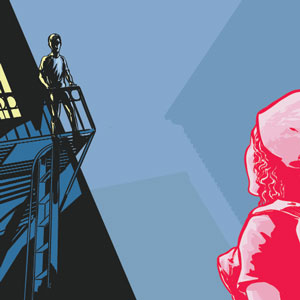
 ** Martyna Majok’s “Sanctuary City” tells a story about minor children of illegal migrants to the United States but has nothing to do with a sanctuary city per se; calling it “The Dreamers” or “Dreams Gone Awry” would have been more apt. Putting that criticism aside, the acting is intense and marvelous, and the dynamics between the three characters are fascinating. But the script is lacking. This 90-minute two-act show with no intermission is unevenly paced with verbiage that throws a lot at the audience at once, but only in the second act do we have an idea where it’s really going. And be prepared to see two halves of a performance which are radically dissimilar in artistry, directing, and style.
** Martyna Majok’s “Sanctuary City” tells a story about minor children of illegal migrants to the United States but has nothing to do with a sanctuary city per se; calling it “The Dreamers” or “Dreams Gone Awry” would have been more apt. Putting that criticism aside, the acting is intense and marvelous, and the dynamics between the three characters are fascinating. But the script is lacking. This 90-minute two-act show with no intermission is unevenly paced with verbiage that throws a lot at the audience at once, but only in the second act do we have an idea where it’s really going. And be prepared to see two halves of a performance which are radically dissimilar in artistry, directing, and style.
The first act describes the agony of being the son or daughter of a migrant who has previously arrived in the United States illegally. While this part of the tale forms an enlightening psychological portrait of two teens, it relies too heavily on telling the audience a story rather than depicting any action. We watch B (Grant Kennedy Lewis) (presumably “boy”) and G (Jocelyn Zamudio) (presumably “girl”) continually exchanging places while dialoguing with each other. Are they busy explaining themselves on different days or at different points in time? Are they imagining what they might tell the other person should they happen to meet them sometime in the future—or are they figuring out what they might choose to tell somebody else about themselves? When everything is just talk and a shifting narrative plays loose and fast with the facts, we start to lose empathy for the characters. We see a lot of interesting personal history combined with a lot of needless detail, such that distinguishing between the two becomes a difficult task for the audience. And while much of this banter begins to make more sense later in the show, by then the audience has already tuned out of a lot of it.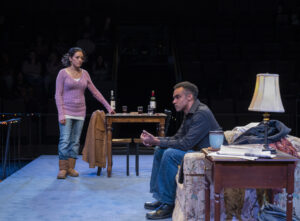
That being said, we learn fairly quickly that G’s mother secretly chose to become a naturalized citizen, meaning that G (who was under eighteen at the time) automatically became a citizen as well. As a consequence, she could now get financial aid and scholarships for college, plus she could be afforded all sorts of prospects for education, jobs, and income, befitting her status. The situation is radically different for B, who likewise traveled with his mother to the United States, but when she chose to leave New Jersey, to return to her native country, he remained without papers. Thus, he could never be eligible for any of the opportunities open only to citizens or those with green cards. For example, he couldn’t attend a good college and was condemned to work under the table in a meaningless job to support himself. The irony is that both B and G knew each other since the third grade and were excellent students at the school they attended.
It is in the second act when we discover that the true focus of the story has to do with marriage in order to become a U.S. citizen. After being incommunicado with B for three-and-a-half years, G finally returns from her college in Boston to New Jersey and meets Henry (Brandon Rivera), B’s gay lover. (Although we never learn what Henry’s immigration status is, we can logically assume that he’s a native-born American, because he is the only character of the three with a real given name, not just an initial.) Now B’s experience being a “Dreamer” merges with that of being gay. Akin to hiding from the authorities due to his lack of documentation, B was hiding his committed relationship and true sexual identity in order to survive in a time period when gay marriage was still illegal. Note that this play is set shortly after 9/11 (2001), at a time when heterosexual marriage was the only type being recognized in terms of procuring a green card and gaining potential citizenship. The obvious implication is that a serious involvement with a gay loving partner meant that you could never become a citizen because of wanting to commit to the person you love. Thus B would be condemned to remain in an underclass as a consequence of the combination of his undocumented status and his sexual orientation.
The audience is not sure exactly what has happened in the three-and-a-half years that fly by between Acts I and II. Why did G never communicate with B over that stretch of time? Did G and B actually have affection for each other or not? And suddenly, why does G want to marry B? Does she love him or feel sorry for him or does her mother want her suddenly to get married? We never really know. Yet the point of B and G’s chatter in the first act becomes clear: They seem to be in some kind of rehearsal for the moment when they imagine themselves in a sham marriage—or possibly a loving marriage. But there is something about the scenario in the second act that doesn’t make sense at all. It is then that the story loses its focus—and my interest.
There are nevertheless some excellent aspects to this production. The way that the directing differs between the two halves points out director Steph Paul’s versatility. The blocking is done beautifully and with finesse throughout; the positioning of all of the actors in a theater-in-the-round setting cannot be excelled! The first act’s entirely bare stage contains a multitude of scenes distinguished only by dramatic changes in the lighting plus some strident sound effects. Incredible lighting design by Reza Behjat ought to win some awards. Bold and intense lights that shift in color and perspective in the first act give way to flat, more realistic illumination in the second act. Sound design by Mikhail Fiksel is good, although there are a few moments when actors facing away from the audience on one end of the room could have been slightly louder. The second act can finally boast of set design and props by scenic designer Yeoji Kim, consisting of a living room and dining area with real furniture. Costumes by Izumi Inaba are appropriate for the era.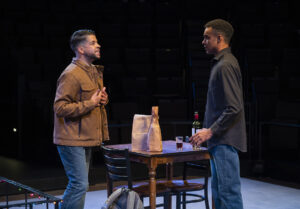
For “Dreamers” like B, the jury is still out about DACA (a/k/a Deferred Action for Childhood Arrivals), and the American public continues to witness how the fate of these young people (now much older) keeps getting postponed—with the lack of a defined immigration policy in this country. However, watching the interaction between G, B, and Henry—and what their affections mean for each other—can teach us something about the impact that the migration experience has on teenagers who seek to obtain legal status in America. But since this play was written, changes in government policy (with the Supreme Court decision of United States v. Windsor in 2013) have made it possible for same-sex couples to have their marriages recognized with regard to immigration issues, such that a spouse can obtain a green card if the other is an American citizen. So while the premise for much of the story is an interesting one—having to do with the prospect of becoming a citizen only through heterosexual marriage—the play has become rather dated. To put it succinctly, sexual orientation is no longer a barrier to marriage and the rights and privileges that go along with it. In addition, the nuance of living in a sanctuary city has also changed over the years. It’s hard to get past the title of the show when we see asylum seekers in locales like Chicago and New York every day in the news—and we learn what it means for them to leave their countries of origin and adjust to a new home and a new set of circumstances.
Although I learned quite a bit from this performance, I felt that the story ought to be better structured, if not rewritten, to make it more relevant to today’s migrant situation. I wanted to like “Sanctuary City” more than I did.
“Sanctuary City” is playing at Steppenwolf Theatre’s Ensemble Theater, 1646 N. Halsted Street, in Chicago, through November 18, 2023.
Single tickets range from $50 to $86, depending on date and time and seat location.
Student tickets are $15.
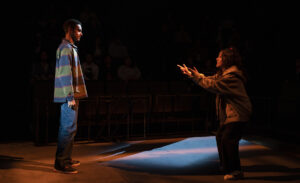 Performance schedule:
Performance schedule:
Tuesdays, Wednesdays, Thursdays, and Fridays – 7:30 p.m.
Saturdays – 3:00 p.m. and 7:30 p.m.
Sundays – 3:00 p.m.
No 7:30 p.m. performance on Wednesday, October 11
Additional performance: 2:00 p.m., Wednesday, October 11
Accessible Performances:
Audio-Described and Touch Tour:
Sunday, October 8 at 3:00 p.m.
(1:30 p.m. touch tour, 3:00 p.m. curtain)
Open-Captioned Public Performances:
Thursday, October 12 at 7:30 p.m.
Saturday, October 21 at 3:00 p.m.
ASL-Interpreted Public Performance:
Friday, October 13 at 7:30 p.m.
Relaxed/Sensory Friendly Public Performance:
Saturday, October 28th at 3:00 p.m.
ASL-Interpreted Student Matinee:
Friday, November 3 at 10:00 a.m.
Spanish Language-Captioned:
Saturday, November 4 at 3:00 p.m.
To purchase tickets, go to: https://cart.steppenwolf.org/overview/18618 or call the Box Office at 312-335-1650.
For more information about “Sanctuary City”, see: https://www.steppenwolf.org/tickets–events/seasons-/202324/sanctuary-city/.
For general information and to learn about Steppenwolf’s other offerings, visit: https://www.steppenwolf.org/.
To see what others are saying, visit www.theatreinchicago.com, go to Review Round-Up anc click at “”Sanctuary City”.



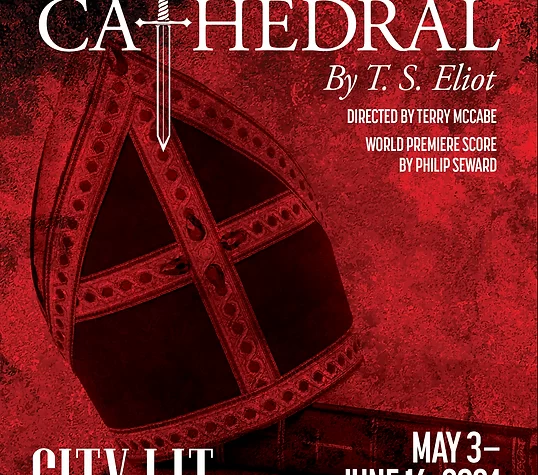


More Stories
“Death Becomes Her”
“Murder in the Cathedral” reviewed by Julia W. Rath
“Viva La Mort: A Play With Song” reviewed by Frank Meccia